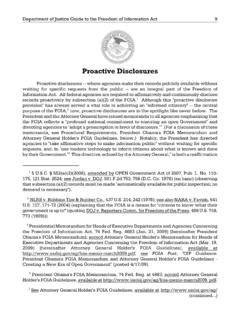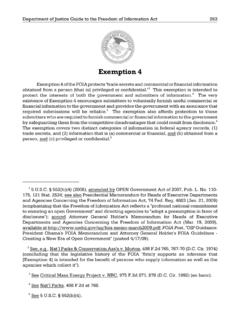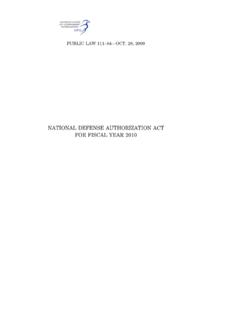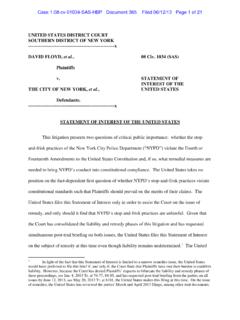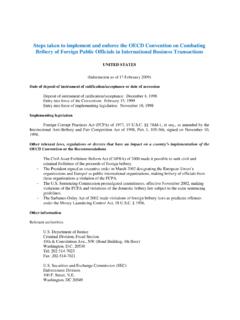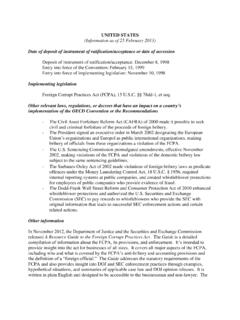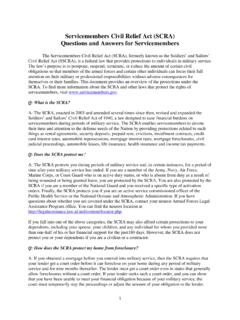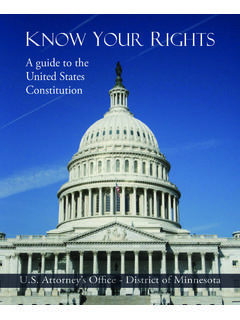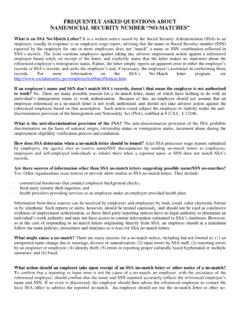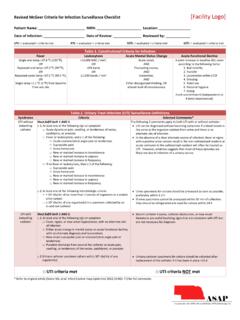Transcription of ELECTRONIC SURVEILLANCE MANUAL PROCEDURES and …
1 ELECTRONIC SURVEILLANCE MANUAL PROCEDURES and CASE LAW FORMS Revised June 2005 (complete in one voliime) FOREWORD This MANUAL was prepared by the ELECTRONIC SURVEILLANCE Unit, Office of Enforcement Operations, Criminal Division, and is designed primarily to assist federal prosecutors and investigative agents in the preparation of ELECTRONIC SURVEILLANCE applications made pursuant to Title 18, United States Code, Sections 2510-2522 (2001) ("Title III") and associated statutes. It is not intended to confer any rights, privileges, or benefits upon defendants, nor does it have the force of a United States Department of Justice directive. See United States v. Caceres, 440 741 (1979). In addition to outlining and discussing the statutory requirements of Title III applications, this MANUAL also sets forth the Department's authorization process, provides guidance in filing Title III pleadings before the court, and discusses the applicable case law as well as both novel, and frequently arising, legal issues involved in Title III litigation.
2 Samples of the most commonly filed pleadings follow the text. INTRODUCTION This MANUAL sets forth the PROCEDURES established by the Criminal Division of the Department of Justice to obtain authorization to conduct ELECTRONIC SURVEILLANCE pursuant to Title 18, United States Code, Sections 2510-2522 (2001) (Title III of the Omnibus Crime Control and Safe Streets Act of 1968, as amended by the ELECTRONIC Communications Privacy Act of 198 6 (ECPA), the Communications Assistance for Law Enforcement Act of 1994 (CALEA), the Antiterrorism and Effective Death Penalty Act of 1996 (Antiterrorism Act)), the USA-Patriot Act of 2001, and the Homeland Security Act of 2002 and discusses the statutory requirements of each of the pleadings. Throughout this MANUAL , the above federal wiretap statutes will occasionally be referred to collectively as "Title III." This MANUAL is divided into two sections. The first section provides an overview of the PROCEDURES to follow when applying for authorization to conduct ELECTRONIC SURVEILLANCE , and discusses format, statutory and policy requirements, and pertinent case law concerning specific ELECTRONIC SURVEILLANCE issues.
3 The second section provides sample forms pertaining to ELECTRONIC SURVEILLANCE involving wire, oral and ELECTRONIC communication interceptions, pen register/trap and trace PROCEDURES , access to transactional data and stored wire and ELECTRONIC communications, and the use of tracking devices. These forms are intended only to provide general guidance in drafting the most frequently used pleadings and do not prohibit alternative approaches. 11 TABLE OF CONTENTS I. THE ELECTRONIC SURVEILLANCE UNIT 1 II. TITLE III AUTHORIZATION PROCESS 1 III. THE ELECTRONIC SURVEILLANCE PLEADINGS 3 1. The Application 3 2. The Affidavit 7 3. The Order 15 IV.
4 ELECTRONIC COMMUNICATIONS 16 1. Coverage under Title III 16 2. Stored ELECTRONIC Communications - 18 2703 16 V. EXTENSION AND SPINOFF APPLICATIONS 19 1. Extension Applications 19 2. Spinoff Applications 21 VI. ROVING INTERCEPTIONS 22 1. Roving Oral Interception 23 2. Roving Wire or ELECTRONIC Interception 24 VII. EMERGENCY PROCEDURES 2 4 1. Title III Interceptions 24 2.
5 Pen Register/Trap and Trace Devices 26 3. How to Contact the ESU 27 VIII. PROGRESS REPORTS 27 IX. SEALING 27 1. Overview 27 2. When to Seal 28 3. Sealing Delays 29 4. How to Seal/Custody of the Tapes 30 5. Suppression for Failure to Seal Properly 30 6. Resealing 31 X.
6 INVENTORY NOTICE 31 XI. DISCLOSURE OF TITLE III EVIDENCE 32 1. 18 2517(1), (2), (6), (7), (8) - Use and Disclosure of Interception Information 32 iii 2. 18 2517(3) - Testimonial Use 34 3. 18 2517(4) - Privileged Communications .. 35 4. 18 2517(5) - Use of "Other Crimes" Evidence 35 XII. DISCOVERY 36 1. 18 2518(9), 2518(10) (a) 36 2. The Federal Rules 37 XIII. PEN REGISTERS/TRAPS AND TRACES 38 XIV. CELL SITE SIMULATORS/DIGITAL ANALYZERS/TRIGGERFISH .. 40 XV. THE LEGAL AUTHORITIES REQUIRED TO LOCATE CELLULAR TELEPHONES 41 XVI.
7 MOBILE TRACKING DEVICES 4 8 XVII. VIDEO SURVEILLANCE 4 8 XVIII. CONSENSUAL MONITORING 50 1. Consensual Monitoring by Law Enforcement 50 2. Consensual Monitoring by Private Parties 51 XIX. CUSTODIAL MONITORING 52 1. Law Enforcement Access to Monitored Prison Calls . 52 2. Case Law on Custodial Monitoring 54 Samples Application for Wire and/or Oral Interceptions 56 Affidavit for Oral and/or Wire Interception 63 Order for Interception of Wire and/or Oral Communications .. 72 Order to Service Provider 77 Sample Minimization Instructions for Oral and Wire Communications 7 9 Application for ELECTRONIC Communications Interception.
8 85 Affidavit for ELECTRONIC Communications Interception .. 90 Order for Interception of ELECTRONIC Communications 99 IV Sample Title III Roving Affidavit 103 Application for Approval of Emergency Interception of Wire, Oral or ELECTRONIC Communications Under 18 2518(7) .. 137 Affidavit in Support of Application for Approval of Emergency Interception of Wire, Oral or ELECTRONIC Communications Under 18 2518(7) 143 Order Approving Emergency Interception of Wire, Oral or ELECTRONIC Communications Under 18 2518(7) .. 153 Application for Sealing 157 Order for Sealing 160 Application for 2703(d) Court Order 162 2703(d)
9 Court Order 164 Application for Trap and Trace/Pen Register 166 Order for Trap and Trace/Pen Register 168 Application for Order Permitting Government To Use Its Own Pen Register/Trap and Trace Equipment (Triggerfish/Digital Analyzer or Similar Device 171 Order Permitting Government To Use Its Own Pen Register/Trap and Trace Equipment (Triggerfish/Digital Analyzer or Similar Device) 173 Combined 3123/2703 Application 175 Combined 3123/2703 Order 189 Application for Video SURVEILLANCE 197 Order for Video SURVEILLANCE 201 Application for Disclosure 204 Order for Disclosure of Interceptions 207 Section 2517(5) Application for Testimonial Use of Interceptions Relating to "Other Offenses" 209 V Section 2517(5))
10 Order Permitting Testimonial Use of Interceptions Relating to "Other Offenses" 212 Inventory Application 214 Order for Inventory 216 Inventory Notice 218 Application for Destruction of Tapes 219 Order for Destruction of Tapes 222 Affidavit for Mobile Tracking Device 224 Order for Mobile Tracking Device 227 VI I. THE ELECTRONIC SURVEILLANCE UNIT The ELECTRONIC SURVEILLANCE Unit (ESU) operates within the Office of Enforcement Operations (OEO), Criminal Division, and handles all requests made pursuant to Title III to conduct non-consensual, domestic SURVEILLANCE of wire, oral, and ELECTRONIC communications for law enforcement purposes.
